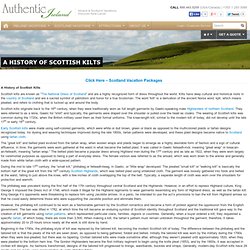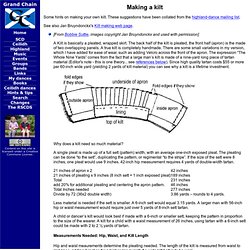

Kilt. One of the earliest depictions of the kilt is this German print showing Highlanders in about 1630 The kilt is a knee-length garment with pleats at the rear, originating in the traditional dress of men and boys in the Scottish Highlands of the 16th century.

Since the 19th century it has become associated with the wider culture of Scotland in general, or with Celtic (and more specifically Gaelic) heritage even more broadly. It is most often made of woollen cloth in a tartan pattern. Although the kilt is most often worn on formal occasions and at Highland games and sports events, it has also been adapted as an item of fashionable informal male clothing in recent years, returning to its roots as an everyday garment. History[edit] History of the kilt. Highland chieftain Lord Mungo Murray wearing belted plaid, around 1680. Scottish Tartans Museum. Kilt history. Introduction... The exact origins of the kilt are uncertain, but this garment, along with the many clan and district tartans in which it is produced, has become a powerful symbol of Scottish identity, history and culture.
Although based on traditons of dress which developed in the 'Highlands' of Scotland, you could say that the kilt forms the basis of a national dress that has come to represent Scotland in it's entirety. The large 'Wraparound' kilt , The 'Feileadh Mor', The 'Feileadh Bhreacain' or the 'Belted plaid', as it has variously been known, is undoubtedly the predecessor of what we recognise as the kilt today.A large piece of material, generally of heavy and dense weave, would have been drawn together by a thick belt, thus transforming it into a piece of clothing, this process probably being expedited by the person in a backward lying position for greater ease.
To be continued... The Scottish Kilt: A Brief History. A History of Scottish Kilts. Click Here – Scotland Vacation Packages A History of Scottish Kilts Scottish kilts are known as “The National Dress of Scotland” and are a highly recognized form of dress throughout the world.

Kilts have deep cultural and historical roots in the country of Scotland and are a sacred symbol of patriotism and honor for a true Scotsman. The word “kilt” is a derivation of the ancient Norse word, kjilt, which means pleated, and refers to clothing that is tucked up and around the body. Scottish kilts originate back to the 16th century, when they were traditionally worn as full length garments by Gaelic-speaking male Highlanders of northern Scotland.
Early Scottish kilts were made using self-colored garments, which were white or dull brown, green or black as opposed to the multicolored plaids or tartan designs recognized today. During the mid to late 17th century, the “small kilt,” phillabeg or feileadh-beag, in Gaelic, or “little wrap” developed. Scottish History - Summary Index. History of the Kilt in Galicia and other Celtic nations - Kilt and Tartan Gallaecia. This page is about Kilt, a knee-length male skirt. If you are looking for information about tartan (a pattern consisting of criss-crossed horizonal and vertical bands in multiple colours), visit the page History of Tartan. The Kilt is a knee-lenght type of male skirt, which became an essential part of the Scottish national dress since the 18th century and was re-introduced in the rest of the Celtic nations as part of the Celtic revival of the 20th century. The Kilt is is internationally renowned as Scotland's national dress and therefore most people believe that the garment was originally created in Scotland.
However, male skirts were common fashion in Atlantic Europe from ancient times up until the introduction of the trousers in the 16th century. In Galicia, male skirts were worn up until the 18th century. Making a kilt. [From Bobbie Suttie, images copyright Jan Bruyndonckx and used with permission] A Kilt is basically a pleated, wrapped skirt.

The back half of the kilt is pleated, the front half (apron) is the made of two overlapping panels. A true kilt is completely handmade. There are some small variations in my version, which I have added for ease of wear, such as adding Velcro across the front of the apron. The expression “The Whole Nine Yards” comes from the fact that a large man’s kilt is made of a nine-yard long piece of tartan material (Editor's note - this is one theory... see references below). Since high quality tartan costs $55 or more per 60-inch wide yard (yielding 2 yards of kilt material) you can see why a kilt is a lifetime investment. Think of a deck of cards, which have been fanned out. The kilt. The famous Scottish kilt originated in the Highlands as an untailored, 5 metre-long piece of cloth that was belted at the waist and known as the féileadh mor in Gaelic, meaning the ‘big kilt’.

Kilt Forum Forums. Geoffrey (Tailor) - Kiltmakers and Weavers - Welcome. Kilts, men's kilts. Kilt maker- McCalman Kilts - visit our online kilt shop. Kapital Kilts -Tranent, East Lothian and Linlithgow, West Lothian, Kilt Sales and Hire. Kilts, Kilt Hire and Kilt Sales, Glasgow, Ayrshire, Scotland. Hand Made Kilts & Tartan Specialists - Kilt Makers, Tartan Specialists, Kilts. Welcome to Hector Russell. Lochcarron of Scotland. Slanj Highlandwear Scotland - Buy Online. Www.thekiltstore.com. Kilt Outfit Packages. Kilts and Scottish Kilts from Edinburgh. Kilts and Authentic Kilt Outfits by Scotweb Kilt and Tartan Store. 21st CENTURY KILTS. What makes a 21st CENTURY KILT special? Howie has reinvented the kilt to make it a practical, modern garment - suited to both casual wear and more traditional formal occasions.
The Original modern3 button jacket If your Kilt is being made to match your Jacket and Vest, this is the way to go. It creates a defined Suit look, giving a complete modern feel. Also works without a sporran or using the front pockets. or 1 Button Argyll21st Century Kilts Style The traditional style I button kilt jacket with a long lapel and then a strong curve away, giving the sporran more prominence.
Vests A jacket is the perfect finishing touch to your kilt suit. 5-Buttons, two normal jetted pockets and the option of the classic V Cut or Curved finish. Hipster Fit No traditional rise, the Kilt will sit at the top of the hip bone for formal and can be loosened for a more modern look. Pockets Detachable and Lined to match the triple fringe etc. Finish Lining in the fringing down the right side. Yardage Chunky Knit Socks.